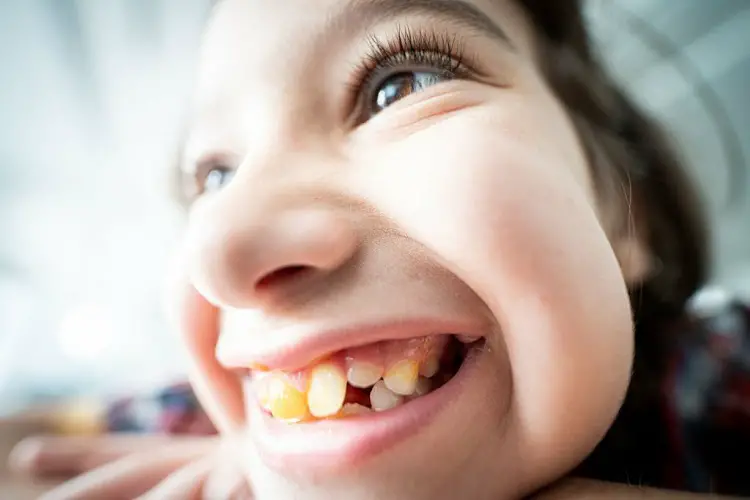Is your baby’s teeth discolored and you’re wondering how to clean baby yellow teeth? Don’t worry, we have all the answers.
As parents, it is essential to maintain good oral hygiene from a young age to promote healthy dental development for the baby.
However, sometimes, our efforts may prove abortive and we find our kid’s teeth discolored.
Teeth discoloration in kids can be due to genetics, poor oral hygiene, and food particles among other causes.
If you’re battling with your baby’s teeth turning yellow, we have suggested the possible causes and their solutions.
Table of Contents
- Teeth Discoloration in Kids
- How To Clean Baby Yellow Teeth
- How To Prevent Baby’s Teeth From Turning Yellow
- Conclusion
Teeth Discoloration in Kids
Tooth discoloration can be intrinsic or extrinsic. External or extrinsic discoloration is usually a temporary condition that causes teeth to turn yellow for various reasons.
In most cases, external discoloration can be easily corrected by improving your child’s oral hygiene habits.
While intrinsic discoloration takes place in the enamel and is usually caused by some medical factors.
It is easy for you to spot yellow teeth in children because of the apparent discoloration, but it sometimes comes in a range of colors and colors can be an indicator of the cause of discoloration.
Other colors you might notice and their interpretation
| Color | Meaning |
| Black | Usually caused by trauma |
| Brown | Caused by injury or eating dark chocolates |
| Orange | Bacteria buildup |
| White | Tooth decay |
| Blue, Red, or Purple | Also trauma or eating dark foods. |
Causes Of Yellow Teeth in Kids
Many reasons can cause yellow teeth in children. It is essential to understand these causes to effectively address the problems and maintain good oral hygiene.
Some common causes of yellow teeth in children include:
Diet
A diet high in sugary foods and drinks can lead to cavities and yellow teeth. Sugar can feed harmful bacteria in the mouth, creating acids that erode the enamel.
Poor hygiene
Insufficient or improper brushing and flossing can lead to plaque buildup on teeth, causing discoloration over time.
Genetics
Some children may have teeth that are naturally discolored or slightly yellow due to genetic factors.
This means that despite good oral hygiene practices, they may still experience discoloration or yellowing of their teeth.
It is important to note that such discoloration is not necessarily an indication of poor oral health or hygiene, and that seeking advice from a dental professional can help determine how best to manage and treat it.
Fluorosis
Excessive exposure to fluoride during tooth development, usually from swallowing too much toothpaste or using too many fluoride supplements, can cause fluorosis.
This condition can cause yellow or brown stains or streaks to appear on the teeth.
Medicine
Some medications, such as the antibiotic tetracycline, when used during tooth development, can cause yellowing or discoloration of teeth. This is more common in children under eight years old.
Injury or trauma
Trauma to primary teeth can cause discoloration. This discoloration can sometimes affect permanent teeth that will develop later.
Illness
Certain diseases and medical conditions, such as high fever or jaundice, can affect the color of teeth, causing them to appear yellow.
Oral hygiene
Some children may not brush and floss diligently, causing plaque and stains to build up.
Iron supplements
Iron supplements, especially when taken in liquid form, can sometimes cause tooth stains in children.
Dehydration
Not drinking enough water can lead to a dry mouth, increasing the risk of stained and discolored teeth.
Habits of teeth grinding and thumb sucking
The habit of grinding teeth can erode tooth enamel, causing teeth to become yellow.
Long-term sucking or pacifier use can sometimes affect the alignment of teeth and lead to tooth discoloration due to changes in enamel thickness.
How To Clean Baby Yellow Teeth

Cleaning your baby’s yellow teeth requires gentle care, attention, and patience to maintain good oral hygiene.
Baby teeth can become discolored for many reasons we will be exploring in this article.
For starts, here are some common causes of teeth discoloration in kids:
- Plaque buildup
- Food stains
- Genetics
If you’re thinking of how to clean baby yellow teeth, here are some practical tips to help you through it:
1. Proper Nutrition
Make sure your baby has a healthy diet, low in sugary foods and drinks. Sugar can contribute to tooth decay and tooth discoloration. Give your baby water as the main drink between meals.
2. Brush Gently
Clean your baby’s teeth as soon as they begin to develop. Use a soft-bristled baby toothbrush such as (Dr. Brown’s Infant-to-Toddler Training Toothbrush) and water.
Avoid using toothpaste until your child is old enough to spit it out, usually around age 2.
3. Brushing Technique
Gently brush your baby’s teeth using circular motions and gentle pressure. Be sure to clean all surfaces of the teeth, including the front and back. Brush regularly, like twice a day, preferably in the morning and before bed.
4. Dental Floss
Once your baby’s two front teeth come in contact, it’s important to start flossing between them to remove any food particles and plaque that may have accumulated.
It’s recommended to use a dental floss that is specifically designed for infants, as it will be gentle on their delicate gums.
Flossing between their teeth can help prevent cavities and tooth decay, and establish good oral hygiene habits early on in life.
Make sure to floss gently and with care, and if you have any concerns or questions, consult with your pediatric dentist.
5. Avoid Bottle Rot
It is important to avoid putting your baby to bed with a bottle, formula, or juice. Doing so can cause a condition called “baby bottle tooth decay” or “nursing bottle syndrome.”
When a baby is put to bed with a bottle, the liquids pool around the teeth and gums, providing a breeding ground for bacteria that can cause tooth decay, cavities, and even gum disease.
This can lead to a range of symptoms, including yellowing of the teeth, sensitivity, pain, and even infection.
To prevent this condition, it is recommended that you only give your baby a bottle during feedings, and never as a way to help them fall asleep.
Additionally, you should wipe your baby’s gums with a clean, damp cloth after feedings, and start brushing their teeth as soon as they appear.
6. Limit Sugary Snacks
To maintain healthy teeth and gums, it is important to limit the intake of sugary drinks and acidic foods between meals as they can harm the enamel and lead to discoloration of teeth.
These types of food and drinks include carbonated beverages, fruit juices with added sugars, candies, and citrus fruits.
Instead, encourage the consumption of healthier choices like fresh fruits and vegetables, which are rich in vitamins and minerals that promote oral health.
Additionally, it’s advisable to rinse your mouth with water after consuming acidic foods or drinks to help neutralize the acids and protect the teeth from damage.
7. Oral Care Products
Use age-appropriate oral care products designed for infants and toddlers. Ask your pediatrician dentist for advice.
8. Lemon and Baking Soda
If your child has stains from food and drink or plaque on their teeth, you can try making a paste from a few drops of lemon juice and baking soda. It is recommended to use this method once a week.
To prepare the paste, simply mix the two ingredients and have your child brush their teeth with it. Leave the paste on for 1 or 2 minutes before brushing again and rinsing well.
However, you should be aware that lemon juice is acidic and can damage enamel if used too frequently. So, it is important to use this method with caution and avoid overusing it.
9. Avoid Soaking Pacifiers
Do not dip pacifiers in sugary substances or honey as this can contribute to tooth decay.
10. Offer Hard Fruits and Vegetables
Encouraging your child to snack on hard fruits and vegetables such as apples, carrots, celery, and pears is a healthy choice.
These foods not only provide essential nutrients but can also help clean the tooth’s surface when chewed.
The tough exterior of these foods may act as a secondary brushing and remove bacteria from the teeth. Additionally, some fruits like apples contain malic acid that can be found in various over-the-counter (OTC) whitening kits.
While doing this, limit sugary drinks & acidic foods like sour candies, sodas, citrus fruits, potato chips & dried fruits to maintain oral health.
Pro Tips:
Schedule Regular Dental Checkups
It is highly recommended to schedule regular dental checkups for your baby. These checkups can help identify any potential oral health issues at an early stage and prevent them from becoming more severe.
During the checkup, your dentist can evaluate your baby’s teeth and gums, provide you with advice on proper oral hygiene practices, and recommend treatment options if necessary.
In addition, your dentist can also discuss with you any concerns you may have about your baby’s tooth discoloration or other cosmetic issues.
Regular professional cleaning can also help keep your baby’s teeth healthy and prevent dental problems in the future.
Therefore, it is crucial to prioritize your baby’s dental health and schedule regular checkups with a trusted dental professional.
Don’t Panic
Discoloration of baby teeth is not uncommon and is not always a sign of a serious problem. If you are concerned about the color of your baby’s teeth, consult your pediatrician dentist for assessment and advice.
Related Posts:
How To Prevent Baby’s Teeth From Turning Yellow
Preventing your child’s teeth from turning yellow includes practicing good oral hygiene and some lifestyle choices.
Here are some tips to help prevent tooth discoloration in babies and children:
- Start dental care as soon as your baby’s first tooth appears.
- Limit sugary drinks and snacks
- Breastfeeding can help prevent cavities and tooth discoloration but if your baby falls asleep while feeding, you should wipe his or her gums with a damp cloth after feeding to remove milk residue.
- Provide a balanced diet that includes a variety of fruits and vegetables.
- Avoid putting your baby to bed with a bottle, formula, juice, or any other sugary liquid at bedtime.
- If you use a bottle, hold the bottle for your baby to drink instead of letting it carry around and constantly sip. This helps minimize prolonged exposure to sugary liquids.
- Limit the use of pacifiers
- Brush their teeth properly
- Model good behavior so that they can take after you.
Conclusion
Baby’s teeth usually act as placeholders for permanent teeth and their health is important for the development of healthy adult teeth.
By following these precautions and maintaining good oral hygiene habits, you can help ensure that your baby’s teeth remain healthy and free of discoloration.
But if your baby’s teeth are already discolored and you’re concerned about how to clean baby yellow teeth, consult a dentist if these suggestions don’t work.
